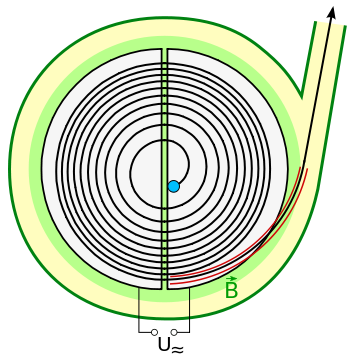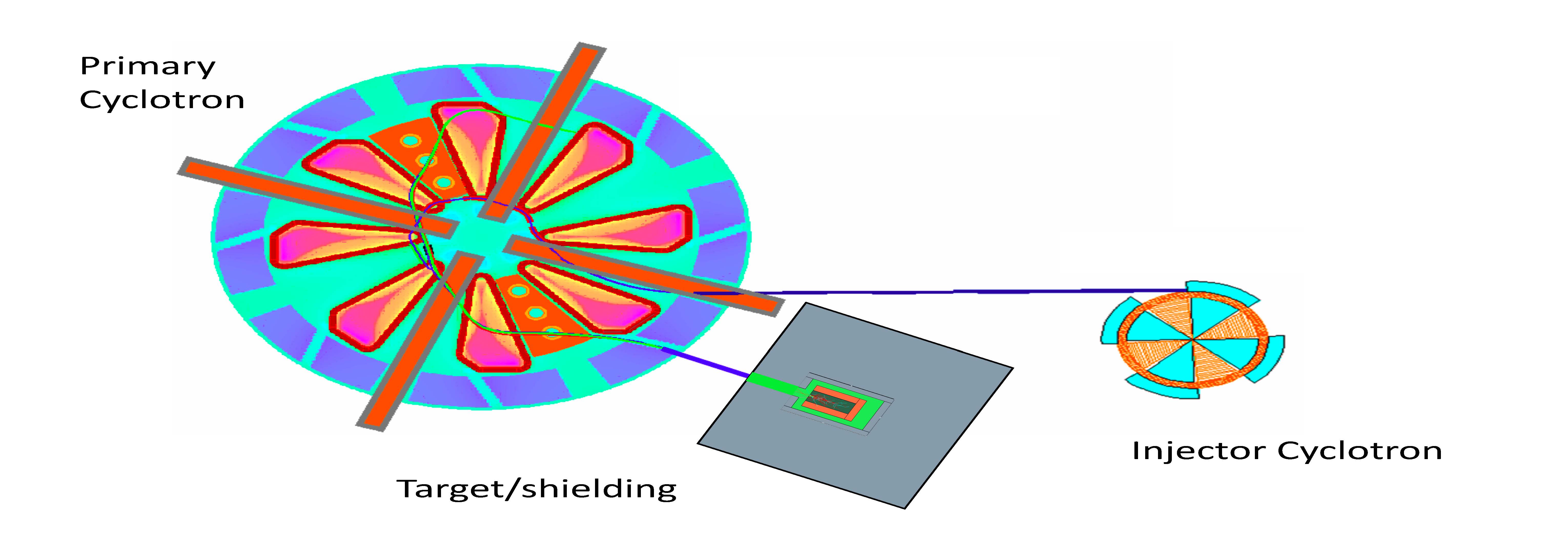
Please see here for the official website
DAEδALUS is a phased neutrino experiment whose ultimate goal is to search for evidence of CP violation in the neutrino sector through the oscillation of muon antineutrinos to electron antineutrinos over short baselines of up to 20 km. The full experiment is still some way in the future, but the phased development provides opportunities for each stage to be used to explore other important areas for more physics results. See, for example, our IsoDAR page which shows the use of the DAEδALUS ion source and injector cyclotron for a search for sterile neutrinos.Cyclotrons accelerate charged particles injected at the center through applying RF waves. Many cyclotrons use a fixed magnetic field and a changing RF frequency, as is illustrated above. However, with this design, it is difficult to reach high intensities. Our cyclotrons use a single RF frequency to accelerate the particles, and vary the magnetic field by shaping the iron of the magnet. The variations are illustrated by the colors in the schematic below. This design allows us to accelerate beams of 5 mA.

The structure of the full DAEδALUS experiment will consist of several cyclotron modules located at three distances (1.5 km, 8 km, and 20 km) from a single detector. Each of these three stations will produce a flux of electron and muon neutrinos as well as muon antineutrinos from the decay-at-rest of positively charged pions and antimuons. Because the amount of electron antineutrinos in the initial neutrino flux is small, the measurement is very sensitive to the oscillation probability of muon antineutrinos to electron antineutrinos. To this end, the near site will be used to constrain the initial neutrino flux and the mid site to constrain the increase in the oscillation probability as a function of distance. The far site will probe the maximum oscillation probability for these muon antineutrinos, which have energies of ~40 MeV. The detector, which will identify electron antineutrinos in the flux through the distinctive inverse beta decay signal, will be a Gadolinium-doped water Cherenkov detector or a liquid scintillator detector on the scale of many kilotons.

Each of the modules at the three stations will be made up from the following components: an H2+ ion source, a DAEδALUS injector cyclotron (DIC), a DAEδALUS superconducting ring cyclotron (DSRC), and a target/dump. There is already a tremendous amount of work and research being done on each of these elements. The H2+ ion source, which, due to the RF phase acceptance of the cyclotrons, will have to produce 30 - 40 mA of beam in order to accelerate just 5 mA, is being prepared by colleagues at INFN Catania. This beam will be injected into the DIC, a cyclotron which will accelerate the H2+ to 60 MeV/amu and then extract it using an electrostatic channel. This beam is then sent to the DSRC which will accelerate it still further, to energies of 800 MeV, before using stripper foils to cleanly extract a beam of protons to be sent to the target/dump. Work on these designs is ongoing, and progressing well.
The use of cyclotrons allows for a more compact, and potentially lower cost, experiment. Furthermore, research and development to progress cyclotron technologies for the DAEδALUS experiment reflects a desire seen in, for example, the medical isotope industry. Consequently, work on the DAEδALUS experiment has immense value even outside neutrino physics. This is important in itself, but also for the willing industry collaboration it brings.
Finally, there are important decisions to be made about exactly where we run, and so where our detector will be. There are many different detector options available to us, such as LENA or MEMPHYS or HYPER-K.
Our Latest work on DAEδALUS
- All our IsoDAR work, which involves building the DIC for the first DAEδLUS module
- The Engineering Study of the DSRC magnet for the DAEδALUS experiment by PSFC at MIT is finished, and can be seen here
Further Reading
- DAEδALUS website
- Cyclotrons as Drivers for Precision Neutrino Measurement arxiv and in Advances in High Energy Physics
- High Current H2+ Cyclotrons for Neutrino Physics: the IsoDAR and DAEδALUS Projects arXiv
- Beam Dynamics Simulation for the High Intensity DAEδALUS Cyclotrons arXiv
- Relevance of IsoDAR and DAEδALUS to medical Radioisotope Production arXiv